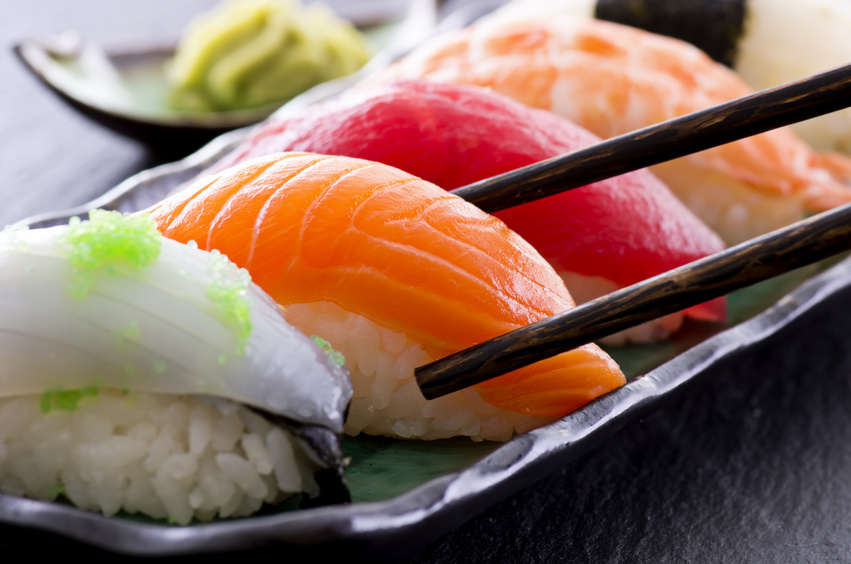
Sushi must be one of the Japanese cuisines you would like to try when you visit Japan. Sushi is indeed one of the soul food for Japanese people, and there are some rules and etiquettes you should follow. Familiarize yourself with some etiquette at sushi restaurants beforehand so that you can fully enjoy your culinary experience without worrying about what is going on around you.
Two different types of sushi restaurants
If you search “sushi” and “Japan” online, you will find plenty of restaurants to choose from. However, you might find the one you liked on the Internet actually so different from what you expected. There are two types of sushi restaurants. Let us explain a bit more in detail.
Conveyer belt sushi restaurants
Conveyer belt sushi restaurants, or kaiten-zushi, are a casual type of sushi restaurants where Japanese people go without worrying about the budget. You will see plates of sushi go around on a conveyer belt across the restaurant. You can grab what you want at your own pace. The colours and patterns of the plates signal the price of each dish, which usually starts from 100 yen per dish. When you finish eating, a member of staff will count the plates to give you a bill. You can also order a particular item from the menu, whether it is a sushi, a soup or a drink. Depending on the restaurant, you might have to place an order by making yourself heard to the staff, or you can simply use touch panel on the device you find on your table. Your order will arrive via the conveyer belt. Try to be attentive while waiting – if you miss it once, you might have to wait for another while for your ordered item to come back to you! Finally, remember that you are not supposed to return a plate once you picked it up from the conveyer belt.
Sushi restaurants without conveyer belt
These must be what you imagine as proper sushi restaurants. If you take a seat at the counter, you can enjoy seeing the chef prepares your sushi. It can be fairly expensive, particularly compared with conveyer belt sushi. So, Japanese people may choose to dine at this type of sushi restaurants on special occasions. It is recommended to book a table in advance. The price is subject to change depending on the seasons and how fresh the ingredients are. The benefits of booking a table in advance are that you can inform the restaurant of your likes and dislikes as well as your budget. This will be useful for the chef to prepare the right ingredients for your visit.
Some etiquette when dining in sushi restaurants
So, you have decided to visit a sushi restaurant. Wouldn’t it be nice to learn some tips beforehand so that you can fully enjoy your sushi experience? Let me introduce several tips to bear in mind on your visit.
Do not wear strong perfume
Aroma of ingredients is an important part of your culinary experience along with its flavour. For example, conger eel is often described that it has similar aroma to that of young leaves of Japanese pepper tree. Such ephemeral scent is also a part of enjoyment of sushi; therefore, it would not be desirable to visit a sushi restaurant wearing a strong perfume. You can ruin other customers’ experience as well as yours.
By hand or with chopsticks? The answer is both are correct
One of the frequently asked questions is whether to eat by hand or use chopsticks when you are at sushi restaurants. The answer is “you can use either”. You can enjoy sushi in whichever way you are comfortable with. However, maki-zushi, or cylindrical sushi wrapped with seaweed, is designed to be eaten by hand. Actually, a layer of seaweed is to make it easier for you eat by hand.
Don’t use too much soy sauce
Some people submerge a piece of sushi in soy sauce, but that can easily ruin the subtle flavour of fish. When eating, try to put only a dash of soy sauce on the fish (not on the rice). It is also useful to know that you are not supposed to fill your sauce dish with too much soy sauce. You simply have to top up little by little as you go along.
Use pickled ginger to refresh your palate
You will soon notice that pickled ginger, or gari, is served with sushi. This is to refresh your palate. The lingering flavour of one dish can undermine the flavour of another you are going to have next. Therefore, eating pickled ginger before having another sushi can be a way to show your respect to the chef. However, you are not supposed to fill your appetite just with pickled ginger – remember that they are there to enhance your sushi experience.
Do not use jargons as a customer
You might hear some unfamiliar words in sushi restaurants such as “Agari”, “O-aiso” and “Murasaki”.*1 These are some of the jargons used by sushi restaurants. Although some Japanese customers sometimes use them, these are not the words customers are supposed to use. For example, “O-aiso”, which means “a bill”, can sound rather rude. It’d be good to know what these jargons mean but you should not use them.
*1“Agari” = hot tea, “O-aiso” = a bill, “Murasaki” = soy sauce
Summary
“Etiquettes” can be described as an antonym for “selfishness”. By adopting the etiquettes explained above, you can pay respect to long-standing culture, show appreciation to the chef, and be thoughtful to other customers. It is a way to demonstrate your consideration. But do not forget to enjoy yourself! While being aware of these etiquettes, do enjoy the Japanese soul food in your own way.
Related Article:
Proper washoku table manners so you don’t embarrass yourself
